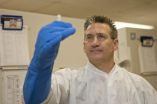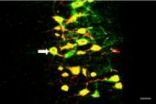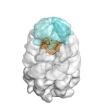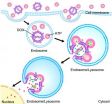(Press-News.org) Short height and long life have a direct connection in Japanese men, according to new research based on the Kuakini Honolulu Heart Program (HHP) and the Kuakini Honolulu-Asia Aging Study (HAAS).
"We split people into two groups – those that were 5-foot-2 and shorter, and 5-4 and taller," said Dr. Bradley Willcox, one of the investigators for the study and a Professor in the University of Hawai`i (UH) John A. Burns School of Medicine's Department of Geriatric Medicine. "The folks that were 5-2 and shorter lived the longest. The range was seen all the way across from being 5-foot tall to 6-foot tall. The taller you got, the shorter you lived."
Researchers at the Kuakini Medical Center, the UH John A. Burns School of Medicine and U.S. Veterans Affairs worked on the study, which was recently published in PLOS ONE, a peer-reviewed medical journal.
The researchers showed that shorter men were more likely to have a protective form of the longevity gene, FOXO3, leading to smaller body size during early development and a longer lifespan. Shorter men were also more likely to have lower blood insulin levels and less cancer.
"This study shows for the first time, that body size is linked to this gene," said Dr. Willcox. "We knew that in animal models of aging. We did not know that in humans. We have the same or a slightly different version in mice, roundworms, flies, even yeast has a version of this gene, and it's important in longevity across all these species."
Dr. Willcox noted that there is no specific height or age range that should be targeted as a cut-off in the study, in part because "no matter how tall you are, you can still live a healthy lifestyle" to offset having a typical FOXO3 genotype rather than the longevity-enhancing form of the FOXO3 gene.
The Kuakini HHP started in 1965 with 8,006 American men of Japanese ancestry born between the years 1900 and 1919. The lifestyles and health conditions of these men were closely followed and studied by the researchers through the years. The Kuakini HHP is the only longitudinal study of Japanese-American men that has included epidemiological and clinical data of the cohorts for almost 50 years. From a worldwide perspective, it is the only research program that maintains a comprehensive, longitudinal database of demographic, lifestyle and medical information, as well as biological specimens collected, from such a large cohort of aging men.
"One of the reasons why Honolulu is perfect for this kind of study is that we have the longest-lived state in the country, combined with a population that has remained, for the most part, in Hawaii. This has helped us maintain one of the longest-running, largest studies of aging men in the world, in the Kuakini Honolulu Heart Program," Dr. Willcox said.
Approximately 1,200 men from the study lived into their 90s and 100s, and approximately 250 of those men are still alive today.
INFORMATION:
Facts at a Glance
Study Conclusions: Shorter men live longer, according to new research based on the Kuakini Honolulu Heart Program (HHP) and Kuakini Honolulu-Asia Aging Study (HAAS). Those men, all of Japanese Ancestry, were followed closely for over 40 years. The findings by researchers at the Kuakini Medical Center, UH John A. Burns School of Medicine and the U.S. Veterans Affairs are published in PLOS ONE, a peer-reviewed medical journal.
The researchers showed that shorter men were more likely to have a protective form of the longevity gene, FOXO3, leading to smaller body size during early development and a longer lifespan. Shorter men were also more likely to have lower blood insulin levels and less cancer.
The researchers suggest that more study is needed to verify the findings and determine whether they can be generalized to other ethnic groups or populations, beyond Americans of Japanese Ancestry.
Study participants: 8,003 American men of Japanese ancestry, whose health conditions were monitored closely for almost 50 years. The men were participants in the Kuakini HHP and Kuakini HAAS (note that the overall count for HHP is 8,006 participants, but three of those did not participate in this study).
Funding: The National Institutes of Health: The National Heart, Lung and Blood Institute, the National Institute on Aging and support from the Office for Research, Kuakini Medical Center, and Development Department of Veterans Affairs.
Complete Researcher Affiliations: Kuakini Medical Center Department of Research; Pacific Health Research and Education Institute of the Veterans Affairs Pacific Islands Health Care System; Department of Geriatric Medicine, John A. Burns School of Medicine; Department of Public Health, UH Mānoa; Department of Human Welfare, Okinawa University.
Link to journal article: http://dx.plos.org/10.1371/journal.pone.0094385
The UH John A. Burns School of Medicine Department of Geriatric Medicine is located at the Kuakini Medical Center. Kuakini is one of the medical school's key community-based partners in training the next generation of physicians, and providing care which is enhanced by rapid access to the latest research and treatment methods.
Honolulu-based study reveals shorter men live longer
2014-05-09
ELSE PRESS RELEASES FROM THIS DATE:
Study strengthens link between neonicotinoids and collapse of honey bee colonies
2014-05-09
Boston, MA — Two widely used neonicotinoids—a class of insecticide—appear to significantly harm honey bee colonies over the winter, particularly during colder winters, according to a new study from Harvard School of Public Health (HSPH). The study replicated a 2012 finding from the same research group that found a link between low doses of imidacloprid and Colony Collapse Disorder (CCD), in which bees abandon their hives over the winter and eventually die. The new study also found that low doses of a second neonicotinoid, clothianidin, had the same negative effect.
Further, ...
How to increase the survival rate of motor neurons after spinal root avulsion
2014-05-09
A previous study showed that, 1 week after avulsion of the spinal nerve root, small motor neurons (< 500 μm2) negative for 27 kDa heat shock protein (HSP27) immunoreactivity died and only large (> 500 μm2) HSP27-positive motor neurons survived in the spinal cord ventral horn. This was followed by the enhancement of HSP27 expression in motor neurons observed after mild crush of the spinal nerve root. Dr. Lin Li and co-workers from Nanjing Medical University in China investigated whether preconditioning crush can increase the survival rate of motor neurons, which ...
Overexpression of Notch1 in temporal lobe epilepsy
2014-05-09
Notch1 signaling can induce astrogliosis in glioma. However, it remains unknown whether Notch1 signaling is involved in the pathogenesis of epilepsy. A recent study by Xijin Liu and co-workers from Huazhong University of Science and Technology in China observed overexpression of Notch1 in the brain tissue of temporal lobe epilepsy rats. After Notch1 regulation, it was relatively effective in reducing seizure frequency and reducing brain discharges, thereby resulting in the ease of seizures to a certain extent. Increased presence of Notch 1 and hairy and enhancer of split-1 ...
Love makes you strong
2014-05-09
It is springtime and they are everywhere: Newly enamored couples walking through the city hand in hand, floating on cloud nine. Yet a few weeks later the initial rush of romance will have dissolved and the world will not appear as rosy anymore. Nevertheless, love and romance have long lasting effects.
Psychologists of the German Universities of Jena and Kassel discovered that a romantic relationship can have a positive effect on personality development in young adults. Researchers report on this finding in the online edition of the renowned science magazine Journal of ...
Molecular high-speed origami
2014-05-09
Proteins are the workhorses of the cell and thus responsible for almost all biological functions including metabolism, signal transmission or the determination of the cell's shape. However, before they can fulfill their various tasks, the chain-like molecules must first adopt an intricate three-dimensional conformation. This process is called protein folding and is one of the most important processes in biology. In fact, in the event of improper folding, proteins are often no more able to carry out their duties, or even tend to clump together in aggregates. This in turn ...
Back to the future to determine if sea level rise is accelerating
2014-05-09
Scientists have developed a new method for revealing how sea levels might rise around the world throughout the 21st century to address the controversial topic of whether the rate of sea level rise is currently increasing.
The international team of researchers, led by the University of Southampton and including scientists from the National Oceanography Centre, the University of Western Australia, the University of South Florida, the Australian National University and the University of Seigen in Germany, analysed data from 10 long-term sea level monitoring stations located ...
Life on cheese
2014-05-09
The rind is the boundary layer between a cheese and its environment. It hosts a variety of microorganisms that comprise the microbiome: a symbiotic community whose members perform different tasks. Some break down proteins and fats on the rind, for example, creating volatile sulphur and ammonia compounds that are responsible for the intensive odour of some types of cheese.
There are different curing methods for cheese. Some, like Limburger, Tilsiter and Appenzeller, need specific bacteria on their rinds. Others, like Camembert and Brie, develop their aroma with the assistance ...
New method sneaks drugs into cancer cells before triggering release
2014-05-09
Biomedical engineering researchers have developed an anti-cancer drug delivery method that essentially smuggles the drug into a cancer cell before triggering its release. The method can be likened to keeping a cancer-killing bomb and its detonator separate until they are inside a cancer cell, where they then combine to destroy the cell.
"This is an efficient, fast-acting way of delivering drugs to cancer cells and triggering cell death," says Dr. Ran Mo, lead author of a paper on the work and a postdoctoral researcher in the joint biomedical engineering program at North ...
Nation's data capital poised to advance leadership position in big data
2014-05-09
WASHINGTON—The Northern Virginia Technology Council (NVTC), the George Washington University (GW), and Attain, LLC, today released a research report conducted by Chmura Economics & Analytics highlighting the depth and breadth of big data experience, expertise and assets in Northern Virginia and the Potomac region.
The report "Big Data and Analytics in Northern Virginia and the Potomac Region" concludes that the area—dubbed the nation's data capital—is a natural leader in the evolving field of big data and analytics. With a concentration of data analytics businesses and ...
Long-term childhood poverty contributes to young adult obesity rates
2014-05-09
A new study from the University of Houston Department of Health and Human Performance (HHP) finds childhood poverty reaches into the lives of white, Hispanic and African-American young adult women, contributing to their propensity to be overweight and obese.
"We know that having a low socioeconomic status during childhood contributes to children being overweight or obese," said HHP's Daphne Hernandez, who also is an executive board member of the UH Texas Obesity Research Center. "We've found a connection between the long-term exposure to poverty during childhood and ...









